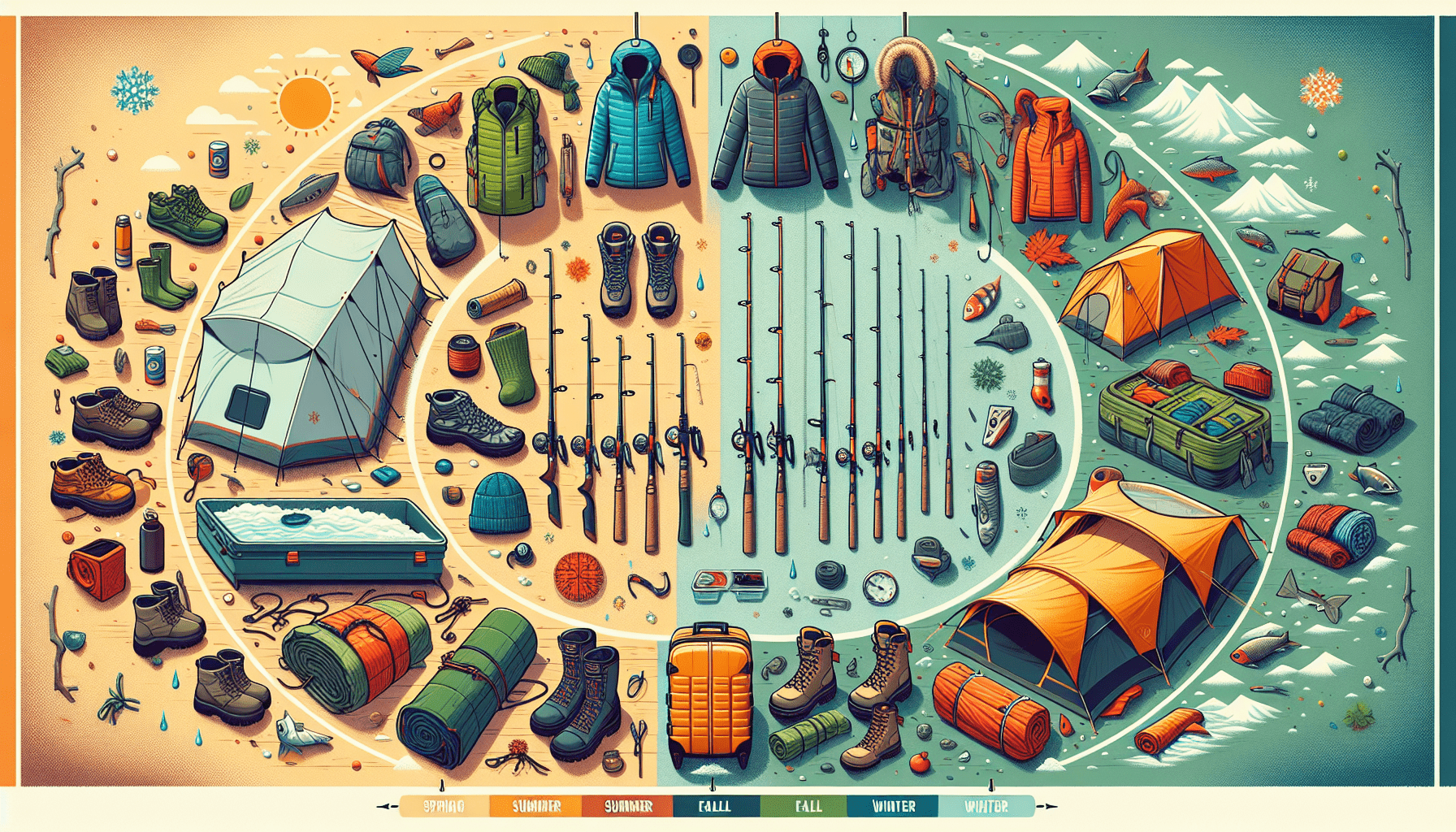So, you’re an adventure enthusiast, always on the lookout for the next thrilling experience. Whether it’s hiking in the summer, skiing in the winter, or camping in the fall, you rely heavily on your gear to make these adventures possible. But have you ever stopped to think about the importance of gear maintenance? In this article, we’ll discuss the significance of regularly maintaining your gear throughout the year, ensuring that it remains in top-notch condition for all seasons of your exciting escapades.

This image is property of images.pexels.com.
Why Gear Maintenance is important
Gear maintenance plays a crucial role in ensuring the longevity and optimal performance of your equipment. Whether you’re an avid outdoor enthusiast or rely on gear for your profession, taking care of your gear will save you money in the long run and enhance your overall experience. Here, we will delve into the reasons why gear maintenance should be a top priority for every adventurer.
Extend the lifespan of your gear
One of the primary reasons why gear maintenance is important is to extend the lifespan of your equipment. Regular cleaning, inspection, and proper storage practices can significantly increase the durability of your gear. By taking proactive measures to maintain and care for your equipment, you can avoid unnecessary wear and tear and prolong its life. This means fewer replacements and more money saved in the long run.
Ensure optimal performance
Imagine embarking on a thrilling mountain hike, only to find that your hiking boots are falling apart or your backpack’s zipper is stuck. Gear failures can turn a potentially enjoyable adventure into a frustrating experience. By regularly maintaining your gear, you can ensure its optimal performance and reliability when you need it the most. Perform routine inspections, lubricate moving parts, tighten screws, and address any issues promptly. This way, you can trust in your gear to perform flawlessly and enhance your outdoor experiences.
Prevent equipment failures
No one wants to be stuck in the middle of nowhere with malfunctioning or broken gear. Regular gear maintenance can help prevent equipment failures. By inspecting for any damage or wear and tear, you can catch potential issues before they escalate into full-blown problems. Additionally, by storing your gear properly, you can protect it from environmental elements that could cause damage. Taking these preventive measures will minimize the risk of equipment failures and ensure you can rely on your gear when you need it most.
General Gear Maintenance Tips
Now that we understand the importance of gear maintenance, let’s explore some general tips that apply to various types of gear and all seasons.
Clean your gear after each use
After a thrilling adventure, the last thing you might want to do is clean your gear. However, this step is crucial to maintain its condition and performance. Whether it’s removing dirt, mud, saltwater, or sweat, cleaning your gear ensures it remains in optimal condition. Follow manufacturer instructions or use mild cleaners to avoid damaging the material. Be sure to rinse and dry the gear thoroughly before storing it.
Inspect for any damage or wear and tear
Regularly inspecting your gear for any signs of damage or wear and tear is essential. Look for tears, holes, loose stitches, or any other visible damage. Check straps, zippers, buckles, and closures to ensure they are functioning properly. By identifying and addressing issues early on, you can prevent further damage and extend the lifespan of your gear.
Store your gear properly
Proper storage is key to preserving the quality of your gear. Make sure to store your equipment in a clean, dry, and well-ventilated area. Avoid exposing it to extreme temperatures or direct sunlight, as these can cause damage over time. Use gear bags, cases, or hangers designed specifically for the type of equipment you’re storing. Keeping your gear organized and protected will contribute to its longevity.
Regularly lubricate moving parts
For gear with moving parts, such as backpack zippers, camping stoves, or bike chains, regular lubrication is crucial. Use lubricants recommended by the manufacturer to ensure compatibility and prevent damage. Lubricating moving parts will reduce friction, promote smooth operation, and prevent premature wear.
Check and tighten any loose screws or fittings
Loose screws or fittings can compromise the integrity and performance of your gear. Regularly check and tighten any loose components to ensure everything is secure. Pay close attention to critical areas like hiking boots, bike handlebars, camping equipment, or any other gear that relies on fasteners. A simple check and tightening can prevent accidents and maintain the functionality of your gear.
Gear Maintenance for Summer Adventures
Summertime brings about exciting outdoor activities such as hiking, camping, water sports, and more. Here are some maintenance tips specifically tailored for your gear during the summer season.
Clean and dry your gear thoroughly
After enjoying fun under the sun, it’s crucial to clean and dry your gear thoroughly. Sand, saltwater, sunscreen, and sweat can all contribute to the deterioration of your equipment. Rinse off any sand or saltwater and use mild soap to clean the gear. Be sure to dry it thoroughly to prevent mold or mildew growth.
Protect against UV damage
Exposure to the sun’s harmful UV rays can damage and fade your gear over time. Look for gear-specific UV protectants or treatments to shield your equipment from the sun’s rays. This is particularly important for items like tents, backpacks, hiking boots, and outdoor furniture that are exposed to direct sunlight for extended periods. Applying UV protectants will extend their lifespan and preserve their vibrant colors.
Check for water resistance
Whether it’s your waterproof hiking boots, tent, or waterproof electronic gadgets, it’s essential to check the water resistance of your gear. Over time, water resistance can diminish due to wear and tear or exposure to harsh conditions. Perform a water resistance test on your gear, following manufacturer instructions, to ensure it’s still capable of keeping you dry during summer adventures.
Inspect for insect or pest damage
During the summer, insects and pests are more active, and they can wreak havoc on your gear. Inspect your gear for any signs of insect or pest damage, such as holes, chewed fabric, or nests. Take preventive measures like using insect repellents or storing your gear in sealed containers to deter unwanted visitors. Address any damage promptly to prevent further deterioration.
Gear Maintenance for Winter Adventures
Winter brings its own set of challenges for gear maintenance. Proper care during this season is essential for the functionality and durability of your equipment.
Remove any ice or snow build-up
During winter adventures, snow and ice can accumulate on your gear. It’s crucial to remove any build-up as it can weigh down your equipment and cause damage. Use a soft brush or cloth to gently remove snow and ice from your gear, avoiding aggressive scraping that may cause scratches or tears.
Check for moisture and dry properly
Winter conditions can expose your gear to moisture, whether it’s from snow, rain, or condensation. It’s essential to check for moisture and ensure your gear is thoroughly dried before storing it. Moisture can lead to mold, mildew, or rust, compromising the integrity of your equipment. Invest in moisture-absorbing agents or drying gear designed for specific items like boots, gloves, or jackets.
Inspect for salt or chemical damage
If you’re engaged in winter activities near roads or in places where ice melters are used, your gear may be exposed to salt or chemicals. These substances can cause damage over time, such as rust or corrosion. Inspect your gear carefully and remove any salt residues promptly. Consider applying protective coatings or treatments to prevent further damage.
Take care of insulation in winter gear
Proper insulation is crucial for winter gear like jackets, sleeping bags, or gloves. Over time, insulation can compress or lose its loft, reducing its effectiveness. Follow manufacturer guidelines to care for the insulation in your gear. Regularly fluff and restore loft in sleeping bags and jackets, and store them uncompressed to maintain optimal insulation.

This image is property of images.pexels.com.
Gear Maintenance for Spring Adventures
As nature comes back to life during spring, it’s time to prepare your gear for new adventures. Here are some maintenance tips to ensure your gear is ready for the season.
Clean off any dirt or mud
Springtime can get muddy, and your gear may bear witness to it. After each outing, clean off any dirt or mud on your equipment. Use a soft brush, mild soap, and water to gently remove the dirt. Pay attention to seams, pockets, and hard-to-reach areas where dirt can accumulate.
Inspect for water damage
Spring showers can surprise you during your adventures. Inspect your gear for any signs of water damage, such as discoloration, stains, or a musty odor. Address water damage promptly to prevent further deterioration and mold growth. Consider reapplying water repellent treatments to gear that has lost its water resistance.
Check for mold or mildew
The increased humidity during spring can create favorable conditions for mold and mildew growth. Inspect your gear for any signs of mold or mildew, such as black spots, musty odors, or discoloration. If you find any, follow manufacturer guidelines or use specific antimicrobial cleaning products to eliminate the fungus and prevent it from spreading.
Inspect zippers and closures
Zippers and closures are essential components of many outdoor gear items. Spring is the perfect time to inspect them and ensure they are functioning properly. Check for any jams, snags, or signs of wear. Lubricate zippers as recommended by the manufacturer to ensure smooth operation. Replace any damaged or malfunctioning zippers or closures to avoid unpleasant surprises during your adventures.
Gear Maintenance for Fall Adventures
As the leaves change colors and the weather becomes crisp, fall adventures offer a unique experience. Here’s how you can maintain your gear during this enchanting season.
Remove any leaves or debris
Fall brings beautiful foliage, but it also means leaves and debris can find their way into your gear. Before storing or using your equipment, ensure that you remove any leaves, twigs, or other debris. Pay close attention to gear like camping stoves, sleeping bags, and backpacks, as leaves can become lodged in crevices or affect their functionality.
Check for wind and waterproof abilities
Fall weather can be unpredictable, with windy and rainy conditions. It’s essential to check the wind and waterproof abilities of your gear. Inspect seams, closures, and any vulnerable areas for signs of wear or damage. Reapply waterproof treatments or seam sealants as needed to ensure your gear remains dry and wind-resistant.
Inspect for rust or corrosion
Fall brings increased humidity and dampness. This can lead to rust or corrosion on metal components of your gear. Inspect your equipment, especially items like camping cookware, tools, or bike parts, for any signs of rust or corrosion. Treat affected areas with rust converters, lubricants, or rust inhibitors to prevent further damage and maintain functionality.
Clean and condition leather gear
Fall offers the opportunity to showcase your stylish leather gear, such as boots, jackets, or belts. It’s essential to clean and condition leather items to keep them in optimal condition. Use a specialized leather cleaner to remove dirt and stains, then apply a leather conditioner to moisturize and protect against drying or cracking.

This image is property of images.pexels.com.
Gear Maintenance for Camping/Hiking Gear
For camping and hiking enthusiasts, reliable gear ensures enjoyable and safe outdoor experiences. Let’s explore maintenance tips specific to camping and hiking gear.
Clean and dry your tent
Your tent is the home away from home during camping adventures. After each trip, clean and dry your tent thoroughly. Follow the manufacturer’s guidelines for cleaning and use mild soap or specialized tent cleaners. Pay extra attention to removing dirt, stains, and mildew. Once cleaned, make sure your tent is completely dry before storing it to prevent mold or mildew growth.
Check and repair tent poles
Tent poles are vital for the structure and stability of your tent. Regularly inspect them for any signs of damage or wear and tear. Look for cracks, bent sections, or broken connectors. If you find any issues, consider repairing or replacing the affected parts promptly. A sturdy and intact tent pole system ensures your tent can withstand various weather conditions.
Inspect and clean your sleeping bag
Your sleeping bag provides warmth and comfort during camping trips, but it’s essential to keep it clean and in good condition. Regularly inspect your sleeping bag for any signs of damage, such as tears, loose stitching, or cold spots. Follow manufacturer instructions for cleaning, as certain sleeping bags may require special care. Use a mild detergent and appropriate water temperature to preserve the insulation and the bag’s overall performance.
Maintain and waterproof your hiking boots
Your hiking boots are your trusted companions on the trails, so it’s vital to maintain them properly. Clean your boots after each hike to remove mud, dirt, and debris. Inspect the boots for any damage or wear, such as loose stitching or delamination. Regularly condition the leather or treat synthetic materials to preserve their water resistance. Pay attention to the soles and replace them when they become worn to ensure optimal traction and stability.
Gear Maintenance for Water Sports Gear
Water sports enthusiasts rely on their gear to make the most of their adventures. Let’s dive into maintenance tips for water sports equipment.
Clean and rinse your wetsuit
Maintaining your wetsuit is vital to preserve its performance and longevity. After each use, rinse your wetsuit with clean, freshwater to remove salt and chlorine. Use specialized wetsuit cleaners or mild soap for a thorough cleaning. Hang it in a shaded area, away from direct sunlight, to dry. Never put your wetsuit in a washing machine or dryer, as this can damage the material.
Check and tighten screws on surfboards
Surfboards endure intense action and can develop loose screws or fittings over time. Regularly check and tighten screws, especially on fin boxes and leash plugs. Use the appropriate tools and torque values recommended by the manufacturer. A well-maintained surfboard will provide stability and control when riding the waves.
Inspect and lubricate kayak or paddleboard joints
The joints and moving parts of your kayak or paddleboard should be inspected regularly for optimal performance. Check for any signs of wear, loose fittings, or stiffness. Lubricate the joints with appropriate lubricants recommended by the manufacturer to ensure smooth operation and prevent damage.
Protect and condition your snorkel gear
Snorkeling gear, such as masks, snorkels, and fins, should be maintained to ensure a comfortable and safe experience. Clean your gear after each use, removing sand, salt, or debris. Rinse with fresh water and dry thoroughly. Apply a specialized silicone or defogging solution to keep your mask clear and prevent fogging. Store your gear in a well-ventilated area away from direct sunlight.

Gear Maintenance for Bike Gear
Cycling enthusiasts understand the importance of maintaining their bikes and gear to ensure a smooth and safe ride. Let’s explore maintenance tips specifically for bike gear.
Clean and lubricate the chain
The bike chain is one of the most critical components and requires regular maintenance. Clean the chain with a specialized degreaser and a chain cleaning tool. Once it’s clean, apply a suitable lubricant to ensure smooth shifting and prevent rust or corrosion. Follow the manufacturer’s instructions regarding the type of lubricant and frequency of application.
Check and adjust brakes and gears
Properly functioning brakes and gears are crucial for a safe and efficient ride. Regularly inspect and adjust your bike’s brakes and gears. Ensure that brake pads are not worn and that the cables are properly tensioned. Lubricate cables and pivot points as needed. If you’re unsure about adjusting brakes or gears, seek the assistance of a professional bike mechanic.
Inspect and replace tires if needed
Your bike tires bear the weight of the rider and endure various road conditions. Regularly inspect your tires for any signs of wear, such as tread depth or sidewall damage. Replace worn-out tires promptly to ensure optimal performance, safety, and grip. Keep in mind the appropriate tire pressure recommended for your bike and adjust accordingly.
Replace worn-out cables or cable housing
The cables and cable housing of your bike control various functions, such as shifting and braking. Over time, cables can stretch, fray, or become less responsive. Regularly inspect your cables and cable housing for damage or wear. Replace any worn-out components to ensure accurate shifting, reliable braking, and a smooth riding experience.
Gear Maintenance for Electronic Gadgets
In this digital age, electronic gadgets have become an integral part of our adventures. Proper maintenance ensures they continue to function reliably. Here are some tips for maintaining electronic gadgets.
Clean and wipe down screens
Electronic screens on devices like smartphones, cameras, or tablets can collect fingerprints, dust, or dirt. Regularly clean and wipe down the screens using a microfiber cloth or specialized screen cleaning solutions. Avoid using abrasive materials or harsh chemicals that could scratch or damage the screens. Keeping your screens clean will enhance visibility and prolong their lifespan.
Ensure proper storage and charging
Proper storage and charging practices are essential for maintaining the lifespan of your electronic gadgets. Follow manufacturer guidelines for storing your devices, including temperature and humidity recommendations. When charging, use the designated charging cables and avoid overcharging. Overcharging can lead to battery degradation and reduced battery life.
Check for software updates
Regularly check for software updates for your electronic gadgets. Software updates often include bug fixes, security patches, and enhancements that can improve the performance and functionality of your devices. Keeping your devices up to date ensures you have the latest features and protection against potential vulnerabilities.
Protect against water or moisture damage
Water or moisture can pose a significant threat to electronic gadgets. Whenever possible, keep your devices away from water sources or use appropriate protective cases. If your device does come into contact with moisture, wipe it down immediately and allow it to dry completely before use. Waterproof cases or sleeves can provide added protection during water-related activities.
Keep gadgets away from extreme temperatures
Extreme temperatures can have detrimental effects on electronic gadgets. Exposure to excessive heat or cold can damage batteries, screens, or internal components. Avoid leaving your devices in hot cars or exposing them to freezing temperatures. When not in use, store your devices in temperature-controlled environments to preserve their longevity.
Gear Maintenance for All Seasons: Preparing for Year-Round Adventures
Maintaining your gear is a crucial part of being an outdoor enthusiast. By following these comprehensive gear maintenance tips, you can ensure the longevity, optimal performance, and reliability of your equipment. Whether you’re embarking on summer hikes, winter adventures, spring excursions, or fall escapades, taking care of your gear will enhance your overall experiences and allow you to make the most of each season. Remember to clean, inspect, store, and repair your gear regularly to avoid equipment failures and unexpected mishaps. With proper gear maintenance, you’ll be well-equipped to embark on any adventure, regardless of the season.


